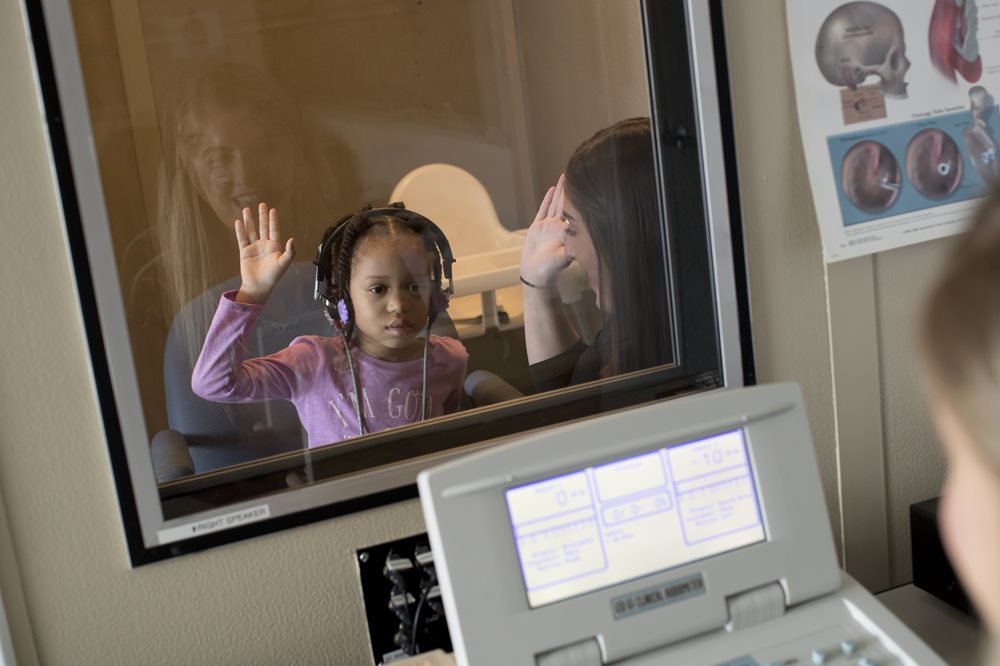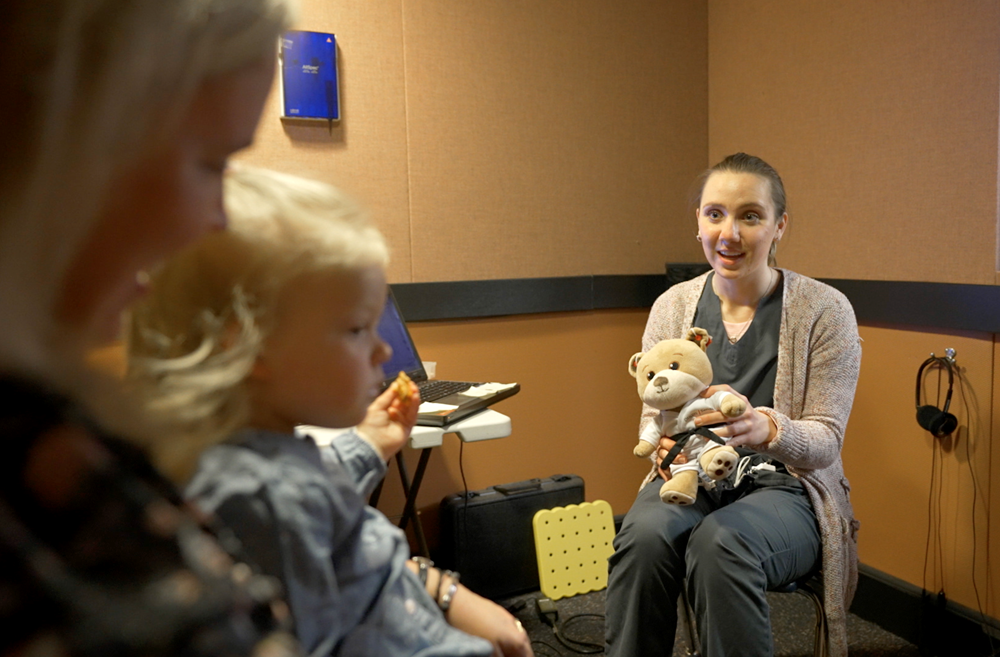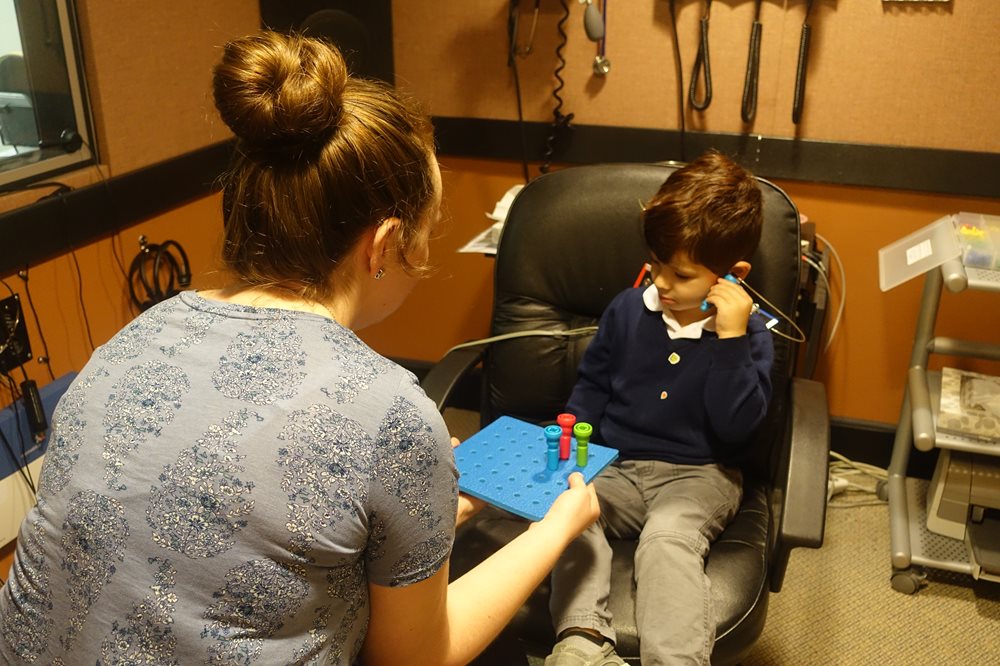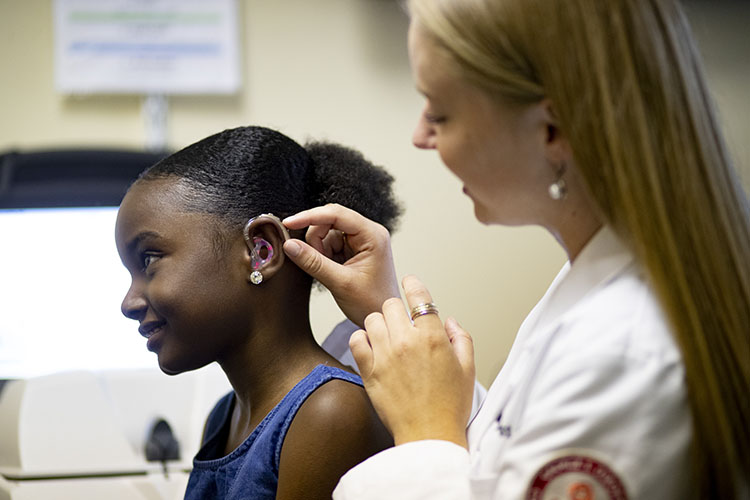Pediatric Audiology Exam
 How is a pediatric hearing exam performed? Dr. Lindsay Bondurant, director of the Pennsylvania Ear Institute and pediatric audiologist with more than twenty years of experience testing children, explains how a typical pediatric exam is performed.
How is a pediatric hearing exam performed? Dr. Lindsay Bondurant, director of the Pennsylvania Ear Institute and pediatric audiologist with more than twenty years of experience testing children, explains how a typical pediatric exam is performed.
According to Dr. Bondurant, a pediatric exam starts with a case history. The audiologist will sit down with the family and ask questions about what types of issues the child might be having, how they seem to respond to sound, their medical history, and if there are any high-risk factors for hearing loss. “Every child is different, so this helps us start building a picture of that parent’s concerns and that specific child’s needs. It also allows us to observe how the child interacts with their parents and with us, which helps us tailor the exam to best suit their abilities and their personality,” said Dr. Bondurant.
The next part of the evaluation involves an examination of the outer ear and ear canal. “We use a special tool called an otoscope, which is really just a very specialized flashlight that we use to look in people's ears,” said Dr. Bondurant. “With kids, it's important because we want to see if they have wax in their ear canal, we want to see that their eardrum looks nice and healthy, that it doesn't have any obvious problems or any issues going on.” Some children are nervous about being in the doctor’s office, Dr. Bondurant noted, so this may be moved to the end of the appointment if the audiologist feels the child is anxious.
 The next step in the exam is checking the middle ear system using tympanometry, during which a probe is placed in the patient’s ear to change the pressure in order to get a sense of how well the eardrum is moving.
The next step in the exam is checking the middle ear system using tympanometry, during which a probe is placed in the patient’s ear to change the pressure in order to get a sense of how well the eardrum is moving.
“For kids, this is really important because a lot of times when children are having trouble hearing, it might be because they have fluid in their middle ear related to ear infections. It's one of the most common reasons that kids go to the pediatrician's office and why they get referred to us for an audiology exam”, said Dr. Bondurant. “If I can get that information from the very beginning, it gives me a really good sense of the health of that portion of the system and gives me a starting point for when I'm going to do the actual hearing evaluation.”
“If a child does have results that are consistent with fluid in the ears or some other middle ear problem, I know it's very likely that they're going to have some hearing loss and I need to start the test at a different level versus a child who has perfectly healthy, normal middle ear function and no history factors that would make me think they might have hearing loss. I'm going to start at a different level for those kids too,” said Dr. Bondurant.
 At this point, the audiologist is taking all the information gathered to this point and is making some predictions about what they’re likely to find during the testing. This helps the test go more smoothly and efficiently by reducing some of the steps that might not be needed.
At this point, the audiologist is taking all the information gathered to this point and is making some predictions about what they’re likely to find during the testing. This helps the test go more smoothly and efficiently by reducing some of the steps that might not be needed.
Following this, the audiologist is ready to conduct the hearing evaluation. The child, often with the parent, are brought into the sound booth for the hearing test. The pediatric exam differs from the traditional hearing test where you raise your hand when you hear the beep. For children, the tests are kid friendly and kid appropriate.
Hearing tests can be conducted on children as young as six months old in the sound booth. Once the child is able to sit up independently, able to control their head and neck and look around for sounds, hearing evaluations can be done.
Younger babies usually sit in the parent’s lap. Sounds are played and the audiologist looks for the child's response. There’s a toy or a video screen that lights up when the child looks for the sound which rewards them for responding and keeps them engaged in the task.
 “Older kids, if they're two and a half, three, four years old, we make it more of a game, which is my favorite way to test kids,” said Dr. Bondurant. “It's called conditioned play audiometry and we make the whole thing a game. Every time you hear the sound, you get to do the next part of the game. You put the peg in the board, the ring on the stack, the ball in the bucket, whatever it is, children that age really have a lot of fun. And, when kids are having fun, I'm having fun too! We can get lots of good information that way.”
“Older kids, if they're two and a half, three, four years old, we make it more of a game, which is my favorite way to test kids,” said Dr. Bondurant. “It's called conditioned play audiometry and we make the whole thing a game. Every time you hear the sound, you get to do the next part of the game. You put the peg in the board, the ring on the stack, the ball in the bucket, whatever it is, children that age really have a lot of fun. And, when kids are having fun, I'm having fun too! We can get lots of good information that way.”
Once children are older, five or six years old, the hearing test is conducted in a more conventional way, though children often need more encouragement to get them back on track.
“There's always things that we're gathering as we do the evaluation, both the information we're getting about the child's hearing, but also, how is the child responding? How are they behaving? Are they able to stick with the whole test? And, that helps us to determine whether they are reliable results or do we need to do something else to figure out what's going on with the child,” said Dr. Bondurant. “So, really, when it's all said and done, I'm looking at all of the information I’ve collected to judge whether or not the child is able to respond to all of the sounds that make up speech.”
 For children who are younger than six months old or who are unable to provide reliable results in the sound booth, other tests might be recommended to assess how well the auditory system is sending sound from the ear canal up to the brain. “There’s no such thing as a child who’s too young for a hearing test” said Dr. Bondurant. “We have really sophisticated technology that can help tell us if hearing loss is present.”
For children who are younger than six months old or who are unable to provide reliable results in the sound booth, other tests might be recommended to assess how well the auditory system is sending sound from the ear canal up to the brain. “There’s no such thing as a child who’s too young for a hearing test” said Dr. Bondurant. “We have really sophisticated technology that can help tell us if hearing loss is present.”
The primary goal is to determine if the child can hear speech clearly. If hearing issues are ruled out, the audiologist can recommend other avenues for the parents to consider to address whatever issues their child may have.
If hearing loss is identified, then further tests are conducted to determine if it’s an issue with the middle ear, which might require a referral for medical treatment, or a more permanent type of hearing loss with the inner ear that might require hearing aids.
“There's a lot of information we're getting, and in the world of pediatrics, we're getting it really quickly because kids don't have the attention span and the stamina that adults do, so we don’t have much time,” said Dr. Bondurant.
 According to Dr. Bondurant, they have to get all that information, put it together, and then go through everything with the parents to really make sure they understand what their child is hearing, what they're not hearing, what it means for their communication and development, their social skills, school, all of those things, and develop a plan of action. “If everything is fine and there’s no hearing loss, then great. We can recommend some other specialists who might be able to help. If we do identify a problem, then here's what the problem is, here's what it means for your child, here's what we can do, and these are the next steps,” she said.
According to Dr. Bondurant, they have to get all that information, put it together, and then go through everything with the parents to really make sure they understand what their child is hearing, what they're not hearing, what it means for their communication and development, their social skills, school, all of those things, and develop a plan of action. “If everything is fine and there’s no hearing loss, then great. We can recommend some other specialists who might be able to help. If we do identify a problem, then here's what the problem is, here's what it means for your child, here's what we can do, and these are the next steps,” she said.
Ultimately, she wants to support the parents in the process, as well as the child. “I want to make sure that they understand the information, that they feel supported, they feel comfortable asking questions, and they know that when all is said and done, the parents have control,” she said. “They are piloting this ship and I'm there to support them and give them the information they need to give their child the tools they need.”